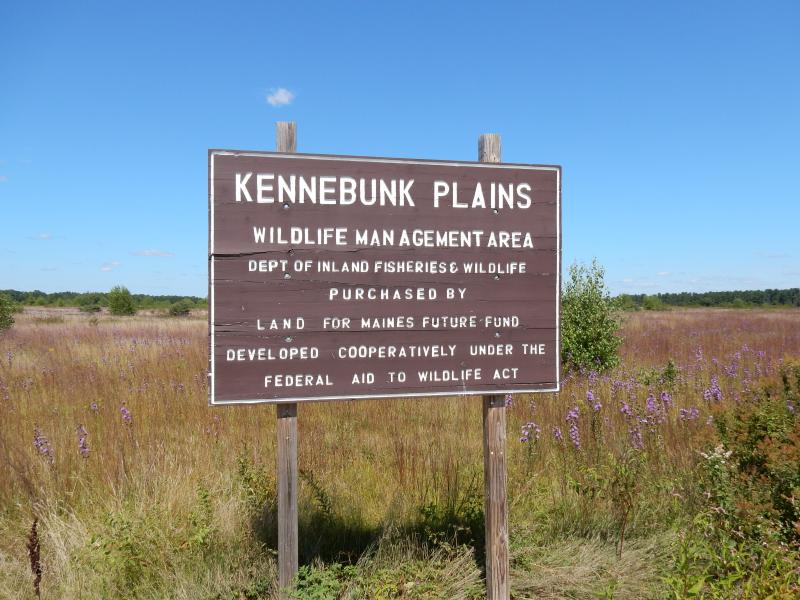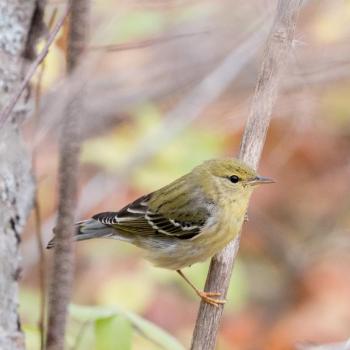A Maine Pledge for Nature
Here in Maine, on the northeastern edge of our great nation, we can sometimes feel pretty distant from the goings on of the rest of the world. But you only have to step outside and spend some time looking and listening for birds to be quickly reminded of the many ways we are indeed connected.
Take the blackpoll warblers that have been passing through Maine in recent weeks. After a summer of singing across their cool Boreal Forest breeding range, they fly southeasterly to the northeastern U.S. and Maritimes of Canada. Considering their breeding range extends from Alaska across Canada to Newfoundland (and with scattered pockets on mountaintops here in Maine and south to the Catskill Mountains of New York), their autumnal migration is especially remarkable. Once they reach the northeastern U.S. and Canadian Maritimes, these tiny birds, smaller than your fist, strike out across the ocean in the dark of night. They fly nonstop for many days, some eventually resting on islands in the Caribbean, others making a direct flight all the way to the South American continent. Quite a few stop just off the shores of Venezuela on the islands of Aruba, Bonaire, or Curaçao to rest and feed. Most spend the winter in northern South America.
How about the black-throated blue warbler? Maine supports more of them than any other state. Black-throated blue warblers love the beech forests of Maine. Their buzzy “Zur-Zur-Zreee” or “I’m so lazeee” songs emanate from those grey-trunked and bright green-leaved forests throughout the early summer. Most of the world’s black-throated blue warblers spend the winter in the big islands of the Caribbean—the Greater Antilles (Cuba, Hispaniola, Jamaica, Puerto Rico).
That’s just two of hundreds of examples of birds that connect Maine to the world, and we haven’t even started on migratory fish and whales and ocean currents. Or wind currents like the ones that brought smoke from massive forest fires on the opposite side of the continent to turn our skies milky white just a few weeks ago.
Maine is connected to the world. That’s why world events going on this week at the United Nations are important to us. To kick off this week leading up to the United Nations Biodiversity Summit, 64 world leaders signed a pledge (the Pledge for Nature) to dedicate their countries to a new higher level of support for nature conservation. Some of these leaders took an even bolder step. Canada, the UK, the European Union, and a number of other countries committed to protecting 30% of their lands and waters by the year 2030 and urged the other nations of the world to follow suit.
These are the kinds of higher-level goals that science tells us are necessary if we are to stop the massive losses of birds and other wildlife that we are seeing around the globe.
While our current U.S. federal government was not among the 64 countries to sign the Pledge for Nature, our own state of Maine has had a history of significant land conservation initiatives. Thirty years ago the Maine Wilderness Act was signed into law by President George H.W. Bush after much work by Maine people and Maine’s congressional delegation. The Natural Resources Council of Maine (NRCM) worked hard on this issue and celebrates this important success in environmental history in a blog by NRCM Forest & Wildlife Director Melanie Sturm. That law established the 12,000-acre Caribou-Speckled Mountain Wilderness along the New Hampshire border just south of Bethel.Maine also took important steps that resulted in 90,000 acres of permanently protected Ecological Reserves within the more than a half-million acres of Public Reserved Lands.
And the 30 years Maine people have been supporting the Land for Maine’s Future program has resulted in more than 600,000 acres of protected lands, the largest parcels in northern and eastern Maine. Land trusts across the state, including our own Boothbay Region Land Trust, have worked tirelessly for decades to bring private donations together to protect natural landscapes that make our communities heathy and livable. These lands also ensure that birds and other wildlife have the habitat they need to survive.
But many parts of Maine continue to see rapid loss of habitat including, often the result of increased demand for second-houses and poorly planned development. We ourselves have seen more special places lost across the state over the years than we’d like to remember. Maine needs a renewed commitment to protecting nature by all of our government leaders, not only around the world, but right here in Maine, too. One important way to move that forward is by ensuring that we get a new bond to bring the necessary funding to renew the Land for Maine’s Future program’s work to protect Maine’s special places.
To achieve, we must have leaders that care about making sure we have a healthy world for our birds, wildlife, forests, and for our kids and grandkids. That’s why voting is so important. The birds and the children can’t vote but we can. Join the leaders of the world in showing your support for nature—get out and vote, for leaders who value nature!
Jeffrey V. Wells, Ph.D., is a Fellow of the Cornell Lab of Ornithology and Vice President of Boreal Conservation for National Audubon. Dr. Wells is one of the nation's leading bird experts and conservation biologists and author of the “Birder’s Conservation Handbook.” His grandfather, the late John Chase, was a columnist for the Boothbay Register for many years. Allison Childs Wells, formerly of the Cornell Lab of Ornithology, is a senior director at the Natural Resources Council of Maine, a nonprofit membership organization working statewide to protect the nature of Maine. Both are widely published natural history writers and are the authors of the popular book, “Maine’s Favorite Birds” (Tilbury House) and “Birds of Aruba, Bonaire, and Curaçao: A Site and Field Guide,” (Cornell University Press).






























